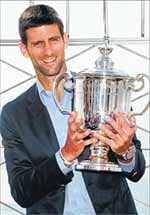Serb on a rare high

If prize money is the measuring stick, Novak Djokovic’s magnificent season is already the best in men’s tennis history – $10.6 million earned and more than two months of paydays still to come. But what if results are the measuring stick?
John McEnroe said on CBS that Djokovic was having “the greatest year in the history of our sport.”
That is quite a statement, given that Djokovic did not complete the Grand Slam by winning all four major singles titles. That unlikely quest ended in June when Roger Federer stopped Djokovic in the twilight in the semifinals of the French Open.
“I don’t want to say that’s not possible,” Djokovic said of a Grand Slam. “It’s possible. Everything is possible. But still, it’s such a tough task to ask to win all four Grand Slams in a year. How many players did it in all history?”
The only men remain Don Budge in 1938 and Rod Laver as an amateur in 1962 and again as a professional in 1969, which was the year after the Open era began.
“Just as a single season, I think Djokovic’s season is the best since Laver in 1969,” said Patrick McEnroe, the commentator and former Davis Cup captain who is the general manager of player development at the US Tennis Association.
Patrick McEnroe, like his brother, points to Djokovic’s relentless consistency and the quality of the fields he is manhandling. Those who remember Federer’s year-long dominance in 2006 have reasonable grounds for argument. But Djokovic’s body of work in 2011 does look clearly superior to every other Open era candidate except Laver and Federer.
Grand Slam singles titles are the trump cards in this comparative exercise, and Djokovic has won three of the four this year. That already puts him in rare company. Only five other men in the Open era have won three majors in a season, and of those, Laver was the only one to sweep all four. Unquestionably great players like Pete Sampras, Bjorn Borg and John McEnroe never won more than two major tournaments in a year, although Borg and, to a lesser degree, McEnroe have a historical handicap in that they regularly skipped the Australian Open, a less prestigious event in their era.
Borg played in it only once, in 1974, which was before he reached his prime. McEnroe played in it five times, reaching the semifinals in 1983 but skipping it in his best season, 1984, in part because the Australian Open was then held at the end of the year, in December, and he was weary of the road.
In 1984, McEnroe lost in the final of the French Open after blowing a two-set lead against Ivan Lendl and then swept to the titles at Wimbledon and the US Open. He compiled an 82-3 singles record, giving him a winning percentage of 96.5 percent, still the best of the Open era.
Djokovic is just ahead of his pace at 97 percent with a 64-2 match record, but unlike McEnroe in 1984, he has those three major titles. Jimmy Connors won three major singles titles in 1974 and went 99-4 overall, but he did not play in the French Open because of a dispute with the French federation over his commitment to World Team Tennis. Mats Wilander won three majors in 1988 but lost in the quarterfinals at Wimbledon. Rafael Nadal won three majors last year but retired in the quarterfinals of the Australian Open.
Then comes Federer, a historical superheavyweight. Federer’s best winning percentage came in 2005, when he just missed tying McEnroe by losing to David Nalbandian in his final match and finished 81-4. But Federer won just two majors that year. He won three in 2004, 2006 and 2007, and he reached the final of the French Open in 2006 and 2007, which gives him the Grand Slam edge over Djokovic in both those seasons.
Look beyond the Slams, though, and the comparison becomes more complicated. Djokovic has won 10 titles in 2011. Only one of those victories came against a relatively weak field. That was the Serbia Open, the event in Belgrade that Djokovic and his family own. Otherwise, he has had to beat the best to raise the trophies, winning an unprecedented five events in the Masters Series, the tournaments with the best fields after the Grand Slam events.
Djokovic is 20-2 against the top 10 in 2011, and one of those losses was a retirement against Andy Murray in Cincinnati. Above all, Djokovic is 6-0 against Nadal and 4-1 against Federer, saving two match points against him in the Open semifinals.
“Novak has two guys who have won double-digit majors, and they are both healthy, and he’s still dominating them,” said Jim Courier, the US Davis Cup captain and a former world No 1. “That’s what’s most impressive about this season, probably.”
Federer did not have two men of his stature to manhandle at his peak. Djokovic has two players of superior stature to underscore his state of grace. “That’s why this feels more astounding to me,” Courier said.
This astounding season is not quite over. Djokovic’s Serbian team is still trying to defend its Davis Cup title and will face Argentina this week in the semifinals, with Djokovic present but uncertain to play. There are the final two Masters Series events of the year in Shanghai and Paris, followed by, if Djokovic’s mind and body are willing, the ATP World Tour Finals in London.
Then, after a short off-season, comes the attempt at an encore in 2012. Djokovic sounded weary just thinking about it on Tuesday. “I think it’s definitely going to take a lot of effort to try to repeat even half of what I have done this year for next year,” he said. “Look, I’m trying to enjoy the present, enjoy this moment.”
Deccan Herald is on WhatsApp Channels| Join now for Breaking News & Editor's Picks